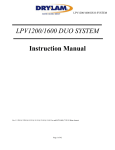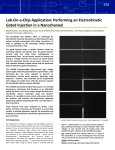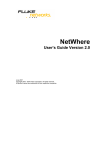Download ADAM-6501 Universal Web-enabled Communication Controller
Transcript
ADAM-6501 Universal Web-enabled Communication Controller User’s Manual Copyright notice This document is copyrighted, 2005, by Advantech Co., Ltd. All rights are reserved. The original manufacturer reserves the right to make improvements to the products described in this manual at any time without notice. No part of this manual may be reproduced, copied, translated or transmitted in any form or by any means without the prior written permission of the original manufacturer. Information provided in this manual is intended to be accurate and reliable. However, the original manufacturer assumes no responsibility for its use, nor for any infringements upon the rights of third parties which may result from such use. Acknowledgements IBM, PC/AT, PS/2 and VGA are trademarks of International Business Machines Corporation. Intel ® and Pentium ® are trademarks of Intel Corporation. Microsoft Windows and MS-DOS are registered trademarks of Microsoft Corp. C&T is a trademark of Chips and Technologies, Inc. All other product names or trademarks are properties of their respective owners. Part No. 2003650100 1st Edition Printed in Taiwan Jan. 2005 1 Product warranty Advantech warrants to you, the original purchaser, that each of its products will be free from defects in materials and workmanship for one year from the date of purchase. This warranty does not apply to any products that have been repaired or altered by persons other than repair personnel authorized by Advantech, or which have been subject to misuse, abuse, accident or improper installation. Advantech assumes no liability under the terms of this warranty as a consequence of such events. Because of Advantech high quality-control standards and rigorous testing, most of our customers never need to use our repair service. If an Advantech product is defective, it will be repaired or replaced at no charge during the warranty period. For out-of-warranty repairs, you will be billed according to the cost of replacement materials, service time and freight. Please consult your dealer for more details. If you think you have a defective product, follow these steps: 1. Collect all the information about the problem encountered. (For example, CPU speed, Advantech products used, other hardware and software used, etc.) Note anything abnormal and list any on-screen messages you get when the problem occurs. 2. Call your dealer and describe the problem. Please have your manual, product, and any helpful information readily available. 3. If your product is diagnosed as defective, obtain an RMA (return merchandize authorization) number from your dealer. This allows us to process your return more quickly. 4. Carefully pack the defective product, a fully completed Repair and Replacement Order Card and a photocopy proof of purchase date (such as your sales receipt) in a shippable container. A product returned without proof of the purchase date is not eligible for warranty service. 5. Write the RMA number visibly on the outside of the package and ship it prepaid to your dealer. Technical support and sales assistance If you have any technical questions about the ADAM-6501 or any other Advantech products, please visit our support website at: http://www.advantech.com/support For more information about Advantech's products and sales information, please visit: http://www.advantech.com 2 Contents CHAPTER 1 ADAM-6501 OVERVIEW ................................................................................................ 4 INTRODUCTION ........................................................................................................................................ 5 1.1 FEATURES ................................................................................................................................... 5 1.2 HARDWARE SPECIFICATIONS ...................................................................................................... 5 1.3 SAFETY PRECAUTIONS ............................................................................................................... 6 1.4 CHASSIS DIMENSIONS ................................................................................................................ 7 CHAPTER 2 HARDWARE FUNCTIONALITY.................................................................................... 8 2.1 2.2 2.3 2.4 2.5 ADAM-6501 PERIPHERALS ....................................................................................................... 9 COM1 & COM2: RS-232/485 INTERFACES ............................................................................. 9 LAN: ETHERNET CONNECTOR ................................................................................................. 10 POWER CONNECTOR ................................................................................................................ 10 LED INDICATORS ...................................................................................................................... 10 CHAPTER 3 INITIAL SETUP ...............................................................................................................11 3.1 INITIAL PROCEDURE .................................................................................................................. 12 3.2 CONFIGURE ADAM-6501 : USCOPE REMOTE DISPLAY TOOL ................................................ 12 CHAPTER 4 : ADVANCED APPLICATION ...................................................................................... 18 4.1 4.2 4.3 INSERT COMPACTFLASH™ CARD............................................................................................. 19 ACTIVESYNC CONNECTION BETWEEN COMPUTER AND ADAM-6501...................................... 19 REMOTE ACCESS SERVER CONFIGURATION ............................................................................ 31 Dial-up configuration ........................................................................................... 31 Dial-in Configuration ............................................................................................ 36 4.4 AUTORUN CONFIGURATION NOTE ............................................................................................ 40 Autorun Configuration Procedure ...................................................................... 40 4.5 APPLICATION DEVELOPMENT PROCEDURE .............................................................................. 44 Application development Procedure.................................................................. 44 4.6 SAVE YOUR SETTINGS ............................................................................................................... 47 4.7 ADAM-6501 NETWORK ADMINISTRATION USER GUIDE ......................................................... 48 4.7.1 Network administration .............................................................................. 49 4.7.2 File Server .................................................................................................... 59 4.7.3 FTP Server.................................................................................................... 65 4.7.4 Telnet Server ................................................................................................ 69 3 Chapter 1 ADAM-6501 Overview This chapter gives background information on the ADAM-6501. It shows you theADAM-6501 overview and specifications. Sections include: ♦ Introduction ♦ Features ♦ Hardware Specifications ♦ Safety Precautions ♦ ADAM-6501 Series ♦ Chassis Dimensions 4 Introduction Advantech ADAM-6501 is a powerful embedded and web-enabled solution platform that connects devices data with enterprise systems. It is possible to access or even diagnose the system problem immediately through any browser. Using Microsoft Windows CE embedded features and compact flash storage, the ADAM-6501 offers a high reliability platform for industrial automation with no risk of hard disk crashes. 1.1 Features The Advantech ADAM-6501 provides users with the most requested functions as seen below: Windows CE-based open embedded system Reliable and Powerful Out-of-Box solution platform The Advantech ADAM-6501 offers the following main features: Embedded web-enabled HMI/SCADA software (Option) HMI/SCADA software and HTTP v1.10 compliant (a persistent connection allows multiple downloads with less overhead, and also improves caching while making it easier to create virtual hosts) web server are established on ADAM-6501 and allow you to remotely view and control I/O data from anywhere on anytime. Rich Legacy Controllers and OPC device connection support With one RS-232 (RJ-48 connector), one RS-485 ports and one Ethernet and industrial standard MODBUS/RTU & MODBUS/TCP drivers, ADAM-6501 can connect versatile I/Os and control devices including Advantech ADAM-4000, 5000 and 6000 series and the other 3rd Party Controller/Device. Windows® CE-based open embedded system With no hard disk needed, the ADAM-6501 features increased reliability. More importantly, Windows® CE (Windows CE.NET 4.2) unfailingly performs time-sensitive tasks with deterministic responses to events. This is a key feature in most industrial applications. Reliable and Powerful Out-of-Box solution platform ADAM-6501 provides reputed industrial hardware with XScale processor and Windows® CE-based embedded software bundled solution. This translates into long-time stability and powerful computing capability to fulfill most different applications. 1.2 Hardware Specifications CPU: XScale 400MHz RAM: 32 MB compact flash memory, 64 MB SDRAM on board Operating System : Microsoft Windows CE.NET 4.2 Storage: 1 External CompactFlash Card Slot(Support up to 512MB CF card, Wireless LAN Card) Serial Port: one RS-232 (RJ-48 connector), one RS-485 ports - Automatic RS-485 data flow control 5 - Data bits: 5, 6, 7, 8 - Stop bits: 1, 1.5, 2 - Parity: none, even, odd - RS-232 max data distance: 50 feet (15.2 meters) - RS-485 max data distance: 4000 feet (1220 meters) Ethernet Port: One 10/100Base-T Ethernet LED: One power LED Power supply voltage: 10-30 VDC, 24VDC recommended Power Requirement: 0.25A typical under +24V power input Power Consumption: 4W (typical) Operating temperature: 0 ~ 55℃ (0 ~ 149℉) 1.3 Safety Precautions The following sections tell how to make each connection. In most cases, you will simply need to connect a standard cable. All of the connector pin assignments are shown in Appendix A. Warning! Always completely disconnect the power cord from your PC chassis whenever you are working on it. Do not make connections while the power is on. A sudden rush of power can damage sensitive electronic components. Only experienced electronics personnel should open the PC chassis. Caution! Always ground yourself to remove any static electric charge before touching ADAM-6501. Modern electronic devices are very sensitive to static electric charges. Use a grounding wrist strap at all times. Place all electronic components on a static-dissipative surface or in a static-shielded bag.. 6 1.4 Chassis Dimensions 7 Chapter 2 Hardware Functionality This chapter shows how to set up the ADAM-6501's hardware functions, including connecting peripherals, switches and indicators. Sections include: ♦ ADAM-6501 Peripherals ♦ RS-232/485 Interfaces Assignment ♦ LAN: Ethernet Connector ♦ Power Connector ♦ LED Indicators 8 2.1 ADAM-6501 Peripherals The following figures show the connectors on ADAM-6501. The following sections give you detail information about function of each peripheral. Figure 2-1: ADAM-6501 front view 2.2 COM1 & COM2: RS-232/485 Interfaces The ADAM-6501 offers twp serial communication interface ports. COM 1is RS-232 ports and COM 2 is RS-485 ports, and Table 2-1 lists the setting of serial ports. Table 2-1: Serial ports default setting COM Port Default Setting COM1 RS-232 (Full RS-232 with RJ-48 connector) COM2 RS-485 Automatic Data Flow Control Function for RS-485 In RS-485 mode, ADAM-6501 automatically senses the direction of incoming data and switches its transmission direction accordingly. Therefore no handshaking signal (e.g. RTS signal) is necessary. This feature lets you simply and quickly build an RS-485 network with just two wires. More importantly, application software previously written for half duplex RS-232 environments can be maintained without need for modification. 9 2.3 LAN: Ethernet Connector The ADAM-6501 is equipped with 10/100 Based-T Ethernet port. The Ethernet port provides a standard RJ-45 jack on board, and LED indicators on the front side to show its Link (Yellow LED) and Active (Green LED) status. 2.4 Power Connector The ADAM-6501 comes with a Phoenix connector that carries 10~30VDC external power input. The recommended power input is 24VDC. 2.5 LED Indicators There are one power LEDs on the ADAM-6501 front panel for indicating system status: ON : Power ON Off : Power OFF 10 Chapter 3 Initial Setup This chapter shows how to initial the ADAM-6501, sections include: ♦ Initial Procedure ♦ Configure ADAM-6501 11 3.1 Initial Procedure The ADAM-6501 offers an easy setup feature: It takes four easy steps for your initial setup before use. Take out the ADAM-6501 from the package and follow the steps below for initial setup: Step 1: Connect all peripheral devices, such as RJ-45 connector of Ethernet connection, RS-232 (RJ-48 connector) and RS-485 connectors. Step 2: Connect the power cord to the ADAM-6501 and plug the other end of the cord into the power outlet, and then ADAM-6501 boots up immediately. Step 3: The ADAM-6501 default IP is set as 10.0.0.1. Please set the IP of your host computer to be static IP : 10.0.0.XXX for connection with ADAM-6501. Step 4: Using the uScope tool to re-configure the IP of ADAM-6501 to meet your network configuration. The path of uScope Remote Display Tool in ADAM-6501 CD is “\uScope Remote Display Tool\uScope.EXE “. 3.2 Configure ADAM-6501 : uScope Remote Display Tool This tool works only with Ethernet connection. it's requires both of your computer and the ADAM-6501 has same Subnet Mask. The default IP address for ADAM-6501 is : 10.0.0.1 and the default Subnet mask is: 255.255.255.0. So you can set your computer IP address to 10.0.0.2 and set the Subnet mask to 255.255.255.0. *actually you can set any IP address that other than 10.0.0.1 from 10.0.0.1 to 10.0.0.255 . If you connected you computer and ADAM-6501 to a router, don't set your computer IP address the same as the Router's. Connect ADAM-6501 with your computer by using a cross-over Ethernet cable. Or connect both ADAM-6501 and your computer into a hub. After ADAM-6501 boot up, it will broadcast it's IP to the network. uScope Remote Display tool running on you computer will detect the UDP message that send out by ADAM-6501 and show the device name and IP in it's 12 device list. You can select and connect to the device (ADAM-6501) in the list as you want. Double Click the uScope icon in configuration computer: Click the “Show List” bottom : Choose the connected device in the list : 13 Click “Connect” After clicking “Connect” bottom, the configuration computer will connect with ADAM-6501. The remote display screen will be as following : 14 Please go to the “Command Prompt” for network IP setting : 15 User can use “ipchange” command for IP change setting in command prompt mode. Please type “ipchange /?” for command reference. Param1 : 1 – Enable DHCP 0 – Disable DHCP Param2 : IP Address Param3 : Subnet Mask (Param2 & Param3 is only available in Param1=0) If the DHCP is choose, the “ipchange 1” will be used as set up command. If this ADAM-6501 will be set as the specific IP address, the setting command and procedure should be as following : Disable DHCP Subnet Mask IP Address 16 Press “Enter”, the remote display screen will show the following message. Wait for the “Saving Registry Done” to make sure the IP change setting work is successfully done. Re-power on the ADAM-6501 module to re-boot the WinCE for new IP address implement. Note : The uScope Remote Display tool is only used for the configuration work. It wasn’t design to run a long time to be used as the remote monitoring tool. 17 Chapter 4 : Advanced Application ♦ Insert CompactFlash™ Card ♦ ActiveSync Connection ♦ Remote Access Service Configuration ♦ Autorun Configuration ♦ Application Development Procedure ♦ Save Your Setting 18 4.1 Insert CompactFlash™ Card The procedure for installing a CompactFlash™ card into the ADAM-6501 is as follows, and please follows these steps carefully. Step 1: Remove the power connector to power off the ADAM-6501 Step 2 : Remove the CF slot cover. Step 3: Plug a CompactFlash™ card with user's OS and application program into a CompactFlash™ card slot on board. Step 4: Plug in the CD slot cover for protecting the CF card. Step 5: Connector the power connector to re-power on the ADAM-6501 Note : How to update the WinCE.NET 4.2 Image for ADAM-6501? Please follow the above steps to plug in the CF card with image (the image file is put in the path:\Image of ADAM-6501 CD. please copy the image file from CD to CF card and please be noticed the format of the CF card must be FAT16) then wait for 5 minutes for rebooting the ADAM-6501 with new image. 4.2 ActiveSync connection between computer and ADAM-6501 • Using a null-modem cable connect ADAM-6501 COM1 with one of COM port on your computer • Install Microsoft ActiveSync software on your computer and make the serial port you want connect with ADAM-6501 available for ActiveSync (see ActiveSync help for details). Note: ADAM-6501 will use 115200 as it default BaudRate to do the ActiveSync connection. If ActiveSync program running on your computer never accept a connection at this BaudRate before, probably you'll get timeout. Since it need scan from low BaudRate to the high BaudRate , if that takes too long, ADAM-6501 will stop trying connect to your computer. So, you'd better use another CE device which has a display to connect to you Desktop through ActiveSync at 19200 BaudRate first. Thus ActieSync on your desktop PC will remember this Baud Rate, and next time when ADAM-6501 try to connect to it at this Baud Rate, it'll be connected easily. ActiveSync Connection The tool is used for the application program on-line programming/debug requirement. User has to install the Microsoft ActiveSync program in configuration computer first. For the detail operating procedure of ActiveSync, please follow the steps by steps operating guide. Step 1 : Setup the ActiveSync in configuration computer 1. Insert ADAM-6501 CD into the CD-ROM in the configuration computer. 2. Install ADAM-6501 Software Development Kit for eVC++ from below path: \Windows CE .NET V4.2\SDK\ADAM6501_SDK.msi 3. Install Microsoft ActiveSync 3.6 from below path: \Windows CE.NET V4.2\Utility\Microsoft ActiveSync 3.6.exe 19 4. Please connect the ActiveSync cable (Null Modem cable, Advantech part no. : 1703093000) to COM1 of ADAM-6501 and the COM port of configuration computer for ActiveSync communication. Step 2 : Please connect the ADAM-6501 via uScope through Ethernet first. Step 3 : Configure the COM1 of ADAM-6501 Press Start of task bar of window system and select “Setting” Æ “Network and Dial-up connections”. A. Click the icon “Make New Connection” to make a new connection. 20 Select the connection type: Direct Connection, then press Next button. B. Choose the COM port of ADAM-6501. In ADAM-6501, there is only COM1 supporting RS-232 for selection. 21 C. Press Start Æ Setting Æ Control Panel, and then click “PC Communication” icon. D. Click Change button to choose your network communication. In this example, change the network communication to “My Connection”. 22 23 Step 4 : Setting the communication environment of the host A. Double click the icon ActiveSync. B. Select FileÆConnection Settings 24 C. Configure the connection settings as below. D. After you configure the connection setting, it will show the below dialog window when you press Get Connected NOTE: Don’t click Next button at this time. 25 E. Press StartÆ Run of ADAM-6501; enter the \windows\repllog.exe in the command line of and press OK button. 26 F. Now, press the Next button in the “Get Connected” dialog in the host. It will build the connection between ADAM-6501 and host.between ADAM-6501 and host. G. If the connection between ADAM-6501 and the host, you will see below message in ADAM-6501. 27 H. If the connection between ADAM-6501 and the host, you will see below message in the host. Select No, then press Next button. I. 28 After the New partnership setting, it will show the below dialog window in the host. J. Press Explore button in Microsoft ActiveSync window, it will pop up the Mobile Device window to display the file resources and information of ADAM-6501 as below: For example, if you click the icon “My Documents’”, you will see the content of storage in ADAM-6501. 29 Step 8 : User can begin to transfer the file from configuration computer to connected ADAM-6501. Double click “My Computer” in “Mobile Device” for file translation. 30 4.3 Remote Access Server Configuration Introduction ADAM-6501 provides “Remote Access Services” which offers the possibilities for remote network and user to have TCP/IP access local mail servers, access to database, web servers or other Intranet services. The following description introduces how to set the dial-up and dial-in configuration. Dial-up configuration Step 1 : Press start of task bar of window system and select “Setting” Æ “Networking and Dial-up connections”. 31 Step 2 : Double click “Make New Connection”, then a dialog window will pop out. Select Dial-Up Connection and press Next >. 32 Step 3 : Setup the device according to the specification of the modem and press Next >. Enter the telephone number in the “Phone Number” window. Press Finish button to complete the dial-up configuration. Step 4 : Press start of task bar of window system and select “Setting” Æ “Networking and Dial-up connections”. Double click the new connection that you made previously (it is RAS Connection in this 33 case), and it will pop out the “Dial-Up Connection” dialog window. Enter your user name / password, then press Dial Properties. 34 Step 5 : Press Dialing Patterns button in the Dialing Properties window. Edit the dialing pattern for each type of call to change how the phone is dialed. NOTE: Country/Region Code, please enter “E” or “e”. Area Code, please enter “F” or “f”. Number, please enter “G” or “g”. Step 6 : Double click My Connection 2 and press Connection button to build a PPP connection. 35 Dial-in Configuration Step 1 : Press start of task bar of window system and select “Setting” Æ “Control Panel”. Step 2 : Double click the RAS Server icon from Control Panel. 36 Step 3 : Select the “General” tab under “Advantech RAS Server Configuration”. Select “Enable RAS”, “Use Static IP Address” and enter a specified IP in Static IP Address blank. Step 4 : Select the “Input Lines” tab under “Advantech RAS Server Configuration”. Click Add button to setup the input line according to the available RAS device. 37 Step 5 : select the “Logon Security” tab under “Advantech RAS Server Configuration”. Select security protocol if necessary. Step 6 : Select the “Logon Security” tab under “Advantech RAS Server Configuration”. Add a new account for remote access services. 38 Step 7 : After all settings are completed, press Apply button and then it will pop up the RasConfig dialog window. Press Yes button to save registry setting to storage card. RAS configuration procedure is completed and you can access ADAM-6501 via remote device. 39 4.4 Autorun Configuration Note Introduction This document introduces how to execute applications automatically when you boot ADAM-6501 up. Autorun Configuration Procedure Step 1 : Execute the “ADAM Configuration Utility” Step 2 : Go to the “Misc” page in ADAM Configuration Utility. 40 Step 3 : Click on the “Program Path” bottom for selecting the program for Auto-Run setting.. 41 Please choose the program then press “OK”. Step 4 : Click on the “Add” bottom to set the program for Auto-Run action. 42 The ADAM Configuration Utility will add the selected program in Auto-Run requirement. Please press “OK” to finish the configuration. 43 4.5 Application Development Procedure Introduction ADAM-6501 provides the Software Development Kit (SDK) and the built-in runtime library; you can use your existing windows-based programming skills to develop applications easily and rapidly through those tools. This document introduces how to develop custom application step by step. Application development Procedure 2. Install Microsoft eMbedded Visual C++ V4.00 with Service Pack 2 The Microsoft eMbedded Visual C++ tool is a desktop development environment for creating applications and system components for Windows CE .NET-powered devices. This version features new capabilities such as C++ exception handling, Run Time Type Information (RTTI), and a plethora of new debugger functionalities. Before you begin to develop your application, you must install Microsoft eMbedded Visual C++ first. 3. Insert ADAM-6501 CD into the CD-ROM in the host PC. 4. Install ADAM-6501 Software Development Kit for eMbedded Visual C++ from below path: \Windows CE.NET V4.2\SDK\ADAM6501_SDK_V1.00.msi 5. Install Microsoft ActiveSync 3.6 from below path: \Windows CE.NET V4.2\Utility\Microsoft ActiveSync 3.6.exe 6. Build the connection between the host and ADAM-6501 via ActiveSync. Further information about ActiveSync, please refer to “ActiveSync Connection”. 7. Execute eMbedded Visual C++. 44 8. Select “File” Æ “New” to open a new project. Select your project type in the left blank of window and enter the new project name / location in the right side of window. Please note that CPU type must select Win32 (WCE ARMV4I). 9. Select “ADAM6501” in the main window of eMbedded Visual C++. 45 10. After you complete above configuration procedure, you can start to develop your application. Press “Build”Æ “Build xxx.exe” to compile your program to .exe file and download it to ADAM-6501. 11. If you want to execute your program, press “Build” Æ “Execute xxx.exe” and then the program will be executed in ADAM-6501. 46 4.6 Save your settings Once you made changes for ADAM6501, you may need run RegSave.exe to save Windows CE system Registry to CF card or on-board flash disk to keep your settings. See Registry Saving section for detail. Registry Saving Running RegSave.exe to save system Registry to CF card or on-board Flash. you can specify command line parameter for RegSave.exe shown as below: RegSave [-f] [-s] [-fs] [-f] : Save Registry to Flash and CF card [-s]: RegSave will not display any message despite whether the action is succeeded or not. [-fs]: combination of [-f] and [-s] If you running RegSave.exe without parameter, it will only save Registry to CF card and it will display message to notify you whether the Registry has been successfully saved. 47 4.7 ADAM-6501 Network Administration User Guide verview Advantech ADAM-6501 series is a built-in Windows ® CE solution offering a pre-configured image with optimized onboard device drivers. Micro Windows ® CE is a compact, high-efficient and hard real-time operating system that is designed for embedded systems without HDD limitation. ADAM-6501 remote administration is a powerful function, which allow users connect to filed-site ADAM-6501 by standard browser and configure ADAM-6501’s network and system settings remotely. ADAM-6501 remote administration includes two major functions; network administration and system administration. z Network administration-With ADAM-6501 well-configured, user can connect to local network or public network (Internet). 48 4.7.1 Network administration Following steps introduces how to connect the ADAM-6501 by standard browser, and configure the field-site ADAM-6501’s network setting remotely. Step1: Execute standard browser (for instance, Internet Explorer), and enter ADAM-6501 (which you would like to connect)’s IP address as below, IP address/networkadmin Instance: 172.18.3.89/networkadmin Step2: System will ask you to enter password when you login ADAM-6501 first time. NOTE: The default user name is ADMIN 49 Step3: Connect to the ADAM-6501 again, and the system will ask you to enter user name and password. After authorization, you will enter Windows CE networking setup page. 50 Network settings Change IP information about the ADAM-6501. 1. Change device name Enter proper device name and press Submit button. Please MUST change ADAM-6501’s device name at your first usage. NOTE: When you change the device name, ADAM-6501 will register his device name to DNS (Domain Name Server) automatically. If you would like to search this ADAM-6501 next time, you can search it by his device name instead of IP address. 51 IPV6 If you want to enable “IPV6”, please check “Enable IPV6” and press Submit button. System will ask you to restart ADAM-6501, the ADAM-6501 will support IPV6 after restarting. 52 Advanced Setting “Advanced setting” function allows ports to be statically reserved and mapped. System will list all of the adapters present on the ADAM-6501. You can configure the adapter bindings as public, private, bridged, or default to simply bind it to TCP/IP. Caution: Incorrect settings may render the ADAM-6501 inoperable. 53 User Accounts “User Accounts” function allows you to add, modify and delete user accounts on this ADAM-6501. 1. Create a user account <1-A> Enter a proper user name in the “Create a new user…” filed, and press Create button. <1-B> Enter a password for this account, and press Create Account button. 54 <1-C> System will create a user account according to your information. If you would like to change the password of this user account, please press Modify button behind the user name. If you would like to delete the user account, please press Delete button behind the user name. 55 2. Create a group <2-A> Enter a proper group name in the “Create a new group…” field, and press Create button. 56 <2-B> If you want to chose which users are members of group, please press Modify button behind the group name. Set the box next the user’s name to have them be part of this group. <2-C> If you want to delete a group, please press Delete button behind the group name. 57 Features Allows configuration of advanced gateway features. You can configure the File server, FTP server and Telnet server accordingly. 58 4.7.2 File Server <A-1> Choose the folder in ADAM-6501 you wish to share and then enter a share name then press “Submit”. 59 <A-2> Press Modify button, and then you can set the permissions for the share folder. If you want to share this folder to anyone on the network, please select “PWD Disable” and press Submit button. 60 How to create a network disk?? Windows CE provides the command to enable remote network disk as a local disk. <Command> Usage: net use [<local name>|*] [<remote name>] [/user:<username>] [/d] or net view <computername> | /DOMAIN:<domainname> <Description> [/d] Disable network disk <Instance> Step1: Share the folder in the remote site to authorized user, and set the permissions (read/write). <EX> Remote Windows PC: <Computer name> = NB940107 <Shared folder name> = David-PC <Authorized user name> = david.lee 61 Step2: Execute the blow command by local ADAM-6501’s command prompt, and system will ask you to enter your user name, password and domain. PS: if you would like to save your user name and password as “default user”, please check “Update Default Credentials”. <EX> net use David-PC \\NB940107\David-PC /user:david.lee 62 63 Step3: The remote network disk (Ex:\\Pocheng-xp\DataCenter) will launch in the local ADAM-6501’s “Network” folder (EX: \Network\DataCenter). 64 4.7.3 FTP Server The FTP server accepts ftp connections and allows the ADAM-6501 to be configured remotely. Basic Configuration You can set following items in Basic Configuration field.. z Server enabled- Will the FTP server accept incoming connections? z Require authentication- Will the FTP server prompt for user name and password? z Allow anonymous users- Allow users without an account on the server to login to the server? z Allow anonymous uploads- Allow anonymous users to upload and change files? z Allow anonymous user to virtual roots- Allow anonymous users to view and access files in virtual roots? z Default Directory- The default directory that anonymous FTP users will log in to. 65 Logs Use Logs section to control what information about the FTP transactions is logged. 66 FTP Users Use FTP Users section to control access to the FTP server for each user. To add new user, please go to the “User Account” page. You can configure a seprate home directory for each user by appending the user’s name to home directory. Denying read permission to a user, denies complete access to the FTP server for that user. 67 Virtual Roots You can add/delete virtual roots to the FTP server. Virtual roots allow you map a physical directory to and directory with a different name. 68 4.7.4 Telnet Server The telnet server accepts telnet connections and allows the ADAM-6501 to be configured remotely. Telnet Server Configuration z Server Enabled- Will the telnet server accept incoming connections? z Require Authentication- Will the telnet server prompt for user name and password? Telnet Server Users Choose which users can access the telnet server. Restart Network Restart for network change to take effect. To make the changes you have made take effect immediately, please press “Restart Networking” button, and then the home gateway networking services will be restart. 69


















































































